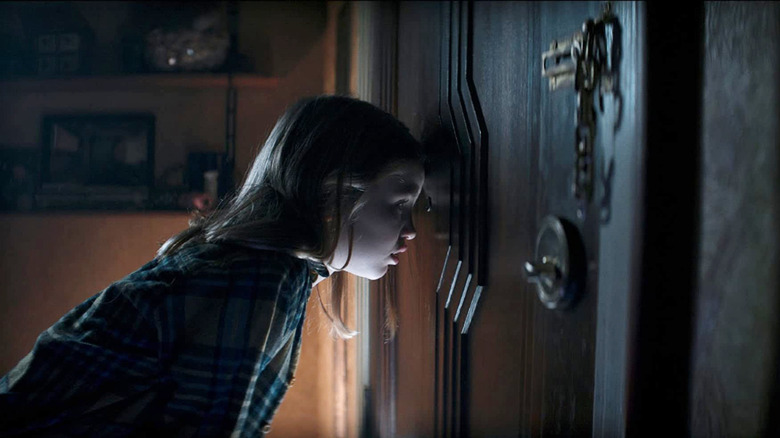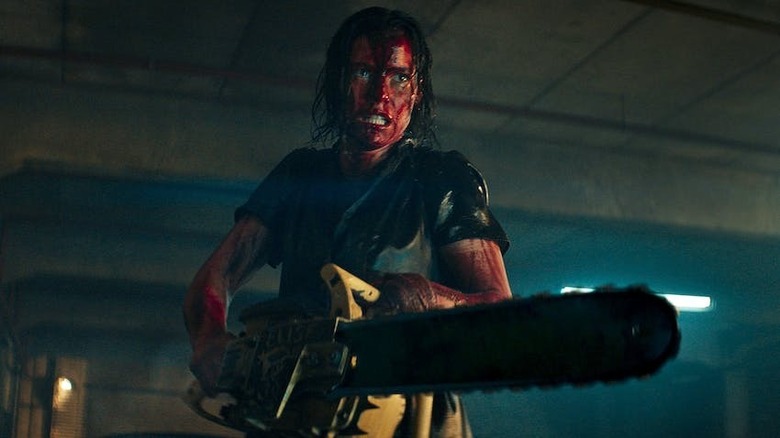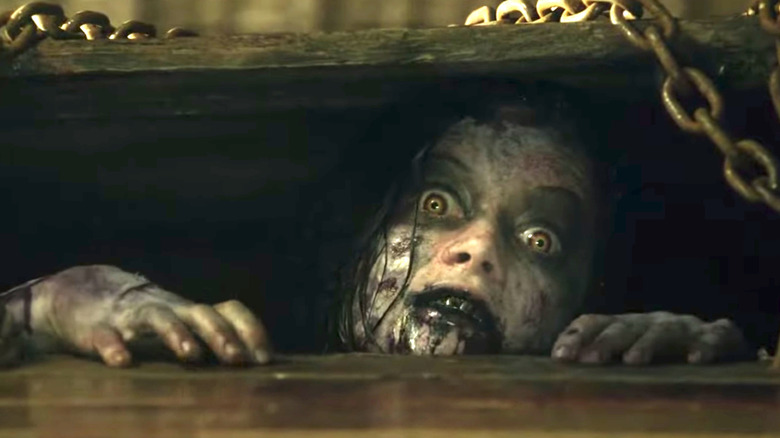Evil Dead Rise Gets One Key Thing Right That The Remake Got Wrong
The Deadites are set to return to theaters this weekend with director Lee Cronin's gloriously unhinged "Evil Dead Rise." Visionary director Sam Raimi's twisted version of the undead bowled over unsuspecting audiences when the original "The Evil Dead" hit in 1981, ushering in a new wave of blood-soaked mayhem and low-budget terror. When Raimi first cracked open the pages of The Necronomicon (a.k.a. the Book of the Dead) in that first film, the overall tone and texture of his breakthrough debut was decidedly darker and grittier than the films that followed. When five innocent college kids accidentally unleash Hell itself at a remote cabin in the woods, the dark spirits found in "The Evil Dead" are only concerned with wreaking as much havoc as possible. If you're Ash (Bruce Campbell), the reality of watching your girlfriend Linda (Betsy Baker) and your buddies transform into possessed soul eaters isn't exactly a fun thing to witness.
"Evil Dead II" is really where Raimi found his splatstick groove and where Campbell was showcased as an incredible cross between Clint Eastwood and Harold Lloyd. Ever since "Evil Dead II," the series has been waffling between the highly entertaining, swashbuckling antics of "Army of Darkness" and the more recent frenzied, graphic violence of Fede Alvarez's incredibly visceral re-imagining, "Evil Dead," in 2013. The Starz TV series "Ash vs Evil Dead" chose action comedy over pure horror, but still managed to stay in the spirit of Raimi's decidedly bonkers trilogy.
Incredibly, all of these iterations still feel like they belong in the world of "Evil Dead," even if Alvarez's deeply satisfying gore fest may have gone a little too far at times. With "Evil Dead Rise," director Lee Cronin (along with producers Rob Tapert, Raimi, and Campbell) has steered the franchise into a slight course correction that brings back the demented glee of the Deadites without doling out violence for the sake of violence.
What Evil Dead Rise gets right
"Evil Dead Rise" not only serves as a continuation and homage to Raimi's original vision, it's also paying respect to Italian director Lamberto Bava's 1986 sequel, "Demons 2." Cronin makes the well-guided decision to take The Necronomicon (and its inevitable victims) out of the forest and place them in an apartment complex, in the same way that Bava moved from a movie theater in "Demons" to a high-rise apartment building.
The switch proves to be just what the "Evil Dead" universe needed, but that doesn't mean it wasn't a risk to take away one of the fundamental aspects and settings of the series. Raimi practically invented the cabin in the woods subgenre, which, at this point, has grown a little stale. While that wasn't necessarily the case when Alvarez's "Evil Dead" hit theaters, the transition to the city immediately breathes some new life into the Book of the Dead.
Focusing on a struggling family instead of a bunch of college kids is also highly effective. When Ellie (Alyssa Sutherland), a single mother of three, is suddenly and viciously possessed and turned into an extremely powerful Deadite, watching her go after her own children is absolutely horrifying. It's Sutherland's twisted contortions and acute comic timing, however, that allow her to tap into that deranged sense of fun that fans have come to know and love about "Evil Dead."
Cronin's direction and editor Bryan Shaw's quick cuts also come remarkably close to matching Raimi's signature style without ever co-opting it. Without a doubt, the real hero of the film is Ellie's younger sister Beth (Lily Sullivan) who steps up to take on the threat and, of course, pick up the chainsaw when the time comes.
What 2013's Evil Dead gets wrong
Sullivan is a true force in "Evil Dead Rise" that's never asked to take on the mantle of Ash or try to reinvent what an action heroine should be in an "Evil Dead" movie. Sullivan actually takes more of a cue from Alvarez's lead character Mia in 2013's "Evil Dead," played superbly by Jane Levy. In Alvarez's film, when Mia becomes possessed, her version of a Deadite has the same joyful, almost euphoric disregard for human life as all the rest of the Necronomicon's minions. The difference is Mia's assailant is just as concerned with harming her as it is with torturing her doomed friends. There's still plenty of glass eating and face ripping in Cronin's new film, but Alvarez's depiction of violence is meant to traumatize the audience instead of entertain us.
There's also the choice of weaponry in "Evil Dead Rise" versus 2013's "Evil Dead" to consider. The nail gun scene in the Alvarez re-imagining is still one of the most gruesome and horrifying scenes in the entire series. Using mostly common household items, Cronin chooses unlikely weapons like a cheese grater to inflict pain, but it's a level of pain you can still get away from. "Evil Dead Rise" uses its violence as a means to an end instead of the be-all and end-all approach Alvarez decided to go with. (A storm of blood is literally raining down at the end of 2013's "Evil Dead," just in case that message wasn't entirely clear.)
Both films are incredible in their own unique ways, and Alvarez's "Evil Dead" walked so that Cronin's "Evil Dead Rise" could run up the walls. Certainly, each version has helped to ensure that the Raimi-verse will be around for years to come.


